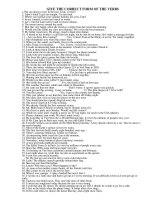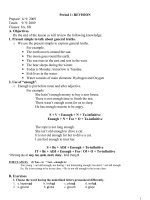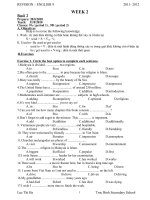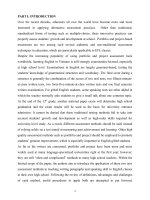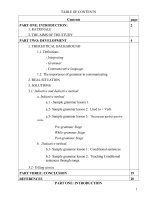bồi dưỡng học sinh giỏi tiếng anh thpt chuyên đề integrating grammar for communicative language (3)
Bạn đang xem bản rút gọn của tài liệu. Xem và tải ngay bản đầy đủ của tài liệu tại đây (1.16 MB, 20 trang )
TABLE OF CONTENTS
Contents
PART ONE: INTRODUCTION:
1. RATIONALE
page
2
2. THE AIMS OF THE STUDY
PART TWO: DEVELOPMENT
4
1. THEREOTICAL BACKGROUND
1.1. Definitions
- Integrating
- Grammar
- Communicative language
1.2: The importance of grammar in communicating
2. REAL SITUATION
3. SOLUTIONS
3.1: Inductive and deductive method.
a. Inductive method
a.1 - Sample grammar lesson 1:
a.2- Sample grammar lesson 2: Used to + Verb
a.3- Sample grammar lesson 3: The present perfect passive
voice
Pre-grammar Stage
While-grammar Stage
Post-grammar Stage
b. Deductive method.
b.1- Sample grammar lesson 1: Conditional sentences
b.2- Sample grammar lesson 2: Teaching Conditional
sentences through songs.
3.2: Telling stories
PART THREE: CONCLUSION
19
REFERENCES
20
1
PART ONE: INTRODUCTION
The importance of grammar in English Language
5 4 3
2
Communication
6
Writing
Railway
= Grammar
Reading
1
Speaking
Listening
7
Grammar
Station = Destination
1- Grammar = is the railway through which your messages will be transported
a train cannot move without railways
is very important in communication
is also the backbone of a language
with the corect grammar, we can express our ideas clearly.
2+3+4+5 = the four communicative skills (Listening, speaking, reading, and
writing) are the cariages which help form a train
6- Communication= The head of the train which is formed by the four domain
skills (Listening, speaking, reading, and writing)
7 – Destination = the destination of the train is the station at this point you can
master a language, it means you can communicate well
=> you won’t be able to convey your ideas to their full extension without a good
command of the grammar patterns and structures of the language.
2
1. RATIONALE
I myself is a teacher of English, I find it necessary to know grammar because
when I have a good command of grammar, I will feel more confident when
communicating. I can explain more specifically about the structures of the sentences,
why they are right, why they are wrong, and because our students are learning
English as a foreign language , not a second language.
As you know, communication has become the heart and soul of the human life.
The process of communication chiefly deals with speaking, listening, reading and
writing. No one really learns grammar. It has become natural phenomenon that we
start speaking what everybody speaks around us. We gradually develop a better sense
of understanding with the passage of time. We don't study grammar of our own
mother tongue to use it for daily speaking, but when we need to polish our own
mother tongue or we want to learn a foreign dialect, we have to study its grammar
and we usually do that.
As far as you can see. Our newly developed English textbook focuses mainly
on improving students’ abilities of speaking and listening. The National
Examination , howerver, focuses almost on the grammar and vocabulary. So how to
help students not only learn well at school but also get high scores in the National
Examination is my biggest concern, and it is also the reason why I write this small
project - “ Integrating grammar for communicative language”
2. THE AIMS OF THE STUDY
The study aims at
- helping students be more interested in learning English Grammar through
some communicative activities
- making English grammar be easy to remember.
- recommending some ways to motivate students’ communicative abilities
- providing a new material for other teachers of English as a kind of reference
material
3
PART 2: DEVELOPMENT
1. THEREOTICAL BACKGROUND
1.1. Definitions
- Integrating: means making into a whole by bringing all parts together
or unifying
- Grammar: is the study of words and the ways words work together; an
invisible force that guides us as we put words together into sentences.
According to Wikipedia, In linguistics, grammar is the set of structural rules
governing the composition of clauses, phrases, and words in any given natural
language. The term refers also to the study of such rules, and this field includes
morphology, syntax, andphonology, often complemented by phonetics, semantics,
and pragmatics.
The formal study of grammar is an important part of education for children
from a young age through advanced learning, though the rules taught in schools are
not a "grammar" in the sense most linguists use the term, particularly as they are
often prescriptive rather than descriptive.
4
When I’m right
No one remembers
But
When I’m wrong
No one forgets
- Communicative language: The communicative approach is based on the idea
that learning language successfully comes through having to communicate real
meaning. When learners are involved in real communication, their natural strategies
for language acquisition will be used, and this will allow them to learn to use the
language.
1.2: The importance of grammar in communicating
Communicating is an essential part of human activities. It is the interaction
between two or more people. It is a two-way process. it involves the sharing ideas
and information between one person and other people. According to Oxford
dictionary, communication is defined as "the activity or process of expressing ideas
and feelings or of giving people information".
Communication is a learned skill. To express themselves well and successfully,
people must learn how to communicate. This is stated by Dimbledy and Burton
(1998) in their book: "abilities such as talking and writing are not natural. They are
taght by parents, friends and schools" (p.6). As a child, a person may learn to
5
communicate by observing others' behaviors and then imitating them. When he or she
grows, it is necessary to go to school where they are taught directly how to
communicate because they can develop better communication skill which is useful
for them.
"Grammatical competence was a part of communicative competence" (Lock, 1996,
p.266). Therefore, to obtain an effective communication skill, people should pay
attention to grammar due to these following reasons.
First, grammar is very importance because it may help enhance accuracy.
Marcel (1853) highlights this point in his book. He clarifies how grammar develops
accuracy in communication as "it forms the mind to habits of order and clearness;
concurrently with logic and rhetoric, it accustoms learners to accuracy of language,
and hence, to accuracy of thinking"(p.424). This means grammar rules can help
learners develop a habit of thinking logically and clearly. Therefore, after studying
grammar, they will become more accurate when using language.
In addition to accuracy, Ellis also says that grammar learning can make the
internalization of syntactic system become easier. Hence, it improves the
development of fluency (Hinkel and Fotos, 2002,p.10). When a person has learned
grammar, it will be easier for him to acquire other grammar rules afterwards
compared to those who have never learned before. That person will know how to
organize and express the ideas in his mind without difficulty. As a result, he will be
able to speak, read or write a language in a smooth and skillful way.
Second, a proper use of grammar is a sign of respect, both for speakers and
listeners (Clack, 2010). For speakers, speaking clearly means they take time to polish
themselves with a good impression from the listeners. A person with a poor grammar
skill can form negative impression on the first time meeting and this may last for a
long time. For listeners, a proper use of grammar shows that their thought is
concerned. Speakers do not want them to waste time trying to figure out what they
are saying.
6
2. REAL SITUATION
In Vietnam, most of the students are afraid of communicating. Why do they shake
with fear of speaking? Why don’t they get out and start speaking? Maybe for fear of
making mistakes? Their grammar is not good?
In our school, many students are good at grammar and writing. However, they often
shake in their shoes just for fear of making mistakes and not being able to express
themselves properly as much as they want to. After 10 years of teaching, I can realise
that these are the most common problems:
Embarrassment: They are embarrassed
because of their accent, poor pronunciation
and because they don’t know how to build
elaborate sentences or in most cases
because they are afraid to be the butt of a
joke in front of others
Vocabulary: A small range of vocabulary or Lack of vocabulary is also one of the
reasons people are afraid of speaking English and they get discouraged to start a
conversation. If you are waiting to achieve a great level of vocabulary to start
speaking English you will end up waiting for years and it will never come to an end.
Lack of Confidence: You don’t feel self-confident enough to engage in a
conversation because your fear is bigger than your confidence plus the three I
mentioned above. Lack of confidence in some cases turns out into negative thoughts
that will break you apart.
7
Mistakes: The fear of speaking also comes from a fear of making mistakes.
Most of the time it happens because people get
anxious and in that case they instantly lose
their ability or capability to speak comfortably,
in some cases, people’s brains get overanxious
and
their
speaking
performance
drops
off substantially, it has been proved that high
levels of anxiety can hold you back, in the
worst case scenario they stop and get stuck
completely.
3. SOLUTIONS
In this part, I am going to suggest some ways of integrating grammar for
communicative language, most of them I have been applying and I can see the
improvement of my students’ communicative skills and their grammar as well.
3.1: Inductive and deductive method.
a. Inductive method
When the teachers take an inductive approach, they start with a set of observations
and then they move from those particular experiences to a more general set of
propositions about those experiences. In other words, they move from data to theory,
or from the specific to the general
a.1 - Sample grammar lesson 1:
You are going to teach your students “Wish” structures. Give them some pictures to
observe and give the situation:
8
You have an appointment with your friend, it suddently rains and, of course you
don’t want it to rain any longer. How will you say?
Students may say:
I hope it will stop raining
I wish It will stop raining
I wish It won’t rain
After some arguments, the teacher may give them the structure of Wish
Future: S+Wish (that) + S + would + Verb
We use 'would' with 'wish' in a little bit of a special way. It's generally used about
other people who are doing (or not doing) something that we don't like and we want
that person to change. It's not usually used about ourselves, or about something which
nobody can change though, exceptionally, we do use it about the weather.
- I wish that it would stop raining!
- I wish that the neighbours would be quiet! (They are not quiet and I don't like the
noise.)
- I wish that you wouldn't smoke so much! (You do smoke a lot and I don't like it. I
want you to change this.)
- I wish that you didn't work late so often.
We don't usually use 'would' when there's no feeling that we want somebody to
change their behaviour.
9
The teacher shows the second picture and say: The girl was lost yesterday because
she didn’t take a map with her. Now she feels regret for what she did yesterday. How
will she say? And the teacher gives students some minutes to discuss. There may be a
variety of answers, the teacher leads them to the correct answer and explains why.
Past : S+Wish (that) + S + had + Verb –past participle
We can use 'wish' with the past perfect to talk about regrets from the past. These are
things that have already happened but we wish they'd happened in a different way.
This use of 'wish' is very similar to the third conditional.
- I wish I had taken a map yesterday. (I didn’t take it)
- I wish that I had studied harder at school. (I didn't study hard at school,
and now I'm sorry about it.)
- I wish that I hadn't eaten so much yesterday! (But I did eat a lot
yesterday. Now I think it wasn't a good idea.)
To present the use of Wish at present. Teachers may call a student who doesn’t really
like English, and then ask her/him.
Teacher: Do you like English?
Do you like
English?
No….
Student: No…
Teacher: Do you want to study English well?
Student: Yes….
Teacher: And….to express your wish at
present we can say “I wish I studied
English well”..can you repeat it?
10
Present: S+Wish (that) + S + Verb-ed
Teachers may give them some other uses of Wish
Wish + to + infinitive:
We can use 'wish' with the infinitive to mean 'would like'. This is very formal. We
don't usually use a continuous tense with 'wish' in this case.
- I wish to speak to the headmaster. (This means the same as 'I would like to speak
to the headmaster'.)
- I wish to go now.
Wish + object + to + infinitive:
In the same way, we can use 'wish' with an object and an infinitive.
I do not wish you to publish this article.
I wish these people to leave.
Wish + somebody + something
This is used mostly in set phrases.
I wished him a happy birthday.
They wished us Merry Christmas.
a.2- Sample grammar lesson 2: Used to + Verb
The teacher shows two pictures of a man. One picture was taken a few years
ago and the other one is new. The old picture shows his habbit of smoking while the
new one displays his saying –no to smoking. The teacher then asks them to compare
the two pictures.
This stage provides a context for input generation and an opportunity to notice
the new grammatical structure. The teacher tells them they are going to learn a new
11
structure (for the purpose of noticing) but does not mention the name of structure
(for motivational purposes).
The teacher asks some clarification check questions to ensure that the meaning
is clear. Some examples:
Did he often smoke in the past?/Does he smoke now?
Did he have long hair in the past?/Does he have long hair now?
The teacher asks the students to formulate the rule on the board for the given
sentence providing help if needed.
He used to
He used to
smoke.
have long hair
=> S + Used to + V-bare infinitive…
The teacher asks students to think back to when they were a child and asks the
following questions:
"What are the differences and similarities between your life then and now?
Think about where you lived, your likes/dislikes, your holidays and your
family, and fill in the following lines with appropriate sentences".
Example:
In the past
Live in the country
Read commic books
Draw
Get up late
Now
Live in the city
Watch TV
Play the piano
Get up early
=> The teachers then ask students to practice making sentences:
I used to live in the country, now I live in the city
(When I was a child I used to read commic books, now I only watch TV
……
I used to be poor
12
a.3- Sample grammar lesson 3: The present perfect passive voice
Pre-grammar Stage
First, the teacher has a discussion on burglaries. Following this
discussion, the teacher asks students to look around the classroom and
remember the names and the positions of some objects in the classroom. Have
all the students go out of the class for some minutes then ask them to come
back again.
While-grammar Stage
The teacher hides some objects in the class before the students come in the
class again. The teacher turns attention to the missing items and says the
following:
"The chalk-cleaner has been taken from the room.
The bag of student A has been stolen.
The small ruler of the teacher has been taken as well.
The picture on the wall has been taken, too".
=> Ask the students to pay more attention to the sentences the teacher has just
said and formulate the rule on the board.
Alternatively, or additionally, the context can be created through a reading text
written in the present perfect passive voice.
Post-grammar Stage
The teacher gives the following hand-out to be filled out and asks students to
walk around and ask questions to the class members.
Find someone
who has been punished by a teacher
who has been invited to a birthday party
who has been told some good news today.
who has been told some bad news today.
who has been misunderstood today.
who has been forgiven by an old friend recently.
who has been given a present today
Class members name
The Teacher asks students to practice making sentences using the present
perfect passive voice
13
b. Deductive method.
It has been said that “deductive means reasoning from the particular to the general.
Deductive reasoning works from the more general to the more specific. Sometimes
this is informally called a "top-down" approach. We might begin with thinking up
a theoryabout our topic of interest. We then narrow that down into more specific
hypotheses that we can test. We narrow down even further when we
collect observations to address the hypotheses. This ultimately leads us to be able to
test the hypotheses with specific data -- a confirmation (or not) of our original
theories.
According to Wilson, “A deductive approach is concerned with developing a
hypothesis (or hypotheses) based on existing theory, and then designing a research
strategy to test the hypothesis” (Wilson, 2010, p.7)
As Babbie, Deductive approach can be explained by the means of hypotheses,
which can be derived from the propositions of the theory. In other words, deductive
approach
is
concerned
with
deducting
conclusions
from
premises
or
propositions. “Deduction begins with an expected pattern that is tested against
observations, whereas induction begins with observations and seeks to find a pattern
within them” (Babbie, 2010, p.52).
In other words, when a deductive approach is being followed in the research
the author formulates a set of hypotheses that need to be tested. Then, through
14
implementation of relevant methodology the study is going to prove formulated
hypotheses right or wrong.
b.1- Sample grammar lesson 1: Conditional sentences
- Explain the defintion of the term “Condional sentences”. Conditional Sentences are
also known as Conditional Clauses or If Clauses. They are used to express that the
action in the main clause (without if) can only take place if a certain condition (in the
clause with if) is fulfilled. There are three types of Conditional Sentences
Teacher gives the forms of the conditional sentences then explain their usages
Type of conditional
sentences
The 1st conditional
sentence
Usages
Forms
Examples
It is possible and also very
if + Simple Present, will-
If I find her address, I’ll
likely that the condition will
Future
send her an invitation
be fulfilled = possible at
present or the future
The 2nd conditional
sentence
It is possible but very
if + Simple
If I found her address, I
unlikely, that the condition
Past, Conditional I (=
would send her an
will be fulfilled = Unreal at
would + Infinitive)
invitation
present
The 3rd conditional
sentence
It is impossible that the
if + Past
If I had found her
condition will be fulfilled
Perfect, Conditional II (=
address, I would have
because it refers to the past
would + have + Past
sent her an invitation
= unreal in the past
Participle)
The teacher asks students to make sentences using the first conditional sentences
Examples:
- If he is late, we will have to go without him.
- If my mother knows about this, we are in serious trouble.
The teacher asks students to make sentences using the second conditional sentences
Examples:
15
- If I knew her name, I would tell you.
- If I were you, I would tell my father.
- If I became president, I would change the social security system
- If I won a million pounds, I would stop teaching.
The teacher asks students to make sentences using the third conditional sentences
Examples:
- If you had studied for the test, you would have passed it.
- If you had asked me, I would have helped you.
- If we had gone to the cinema, we would have seen my friend Jacob.
- If you had spoken English, she would have understood.
- If they had listened to me, we would have been home earlier.
- I would have written you a postcard if I had had your address.
- If I had not broken my leg, I would have taken part in the contest.
- If it had not started to rain, we would have walked to the museum.
- We would have swum in the sea if there had not been so many sharks there.
- If she had taken the bus, she would not have arrived on time.
b.2- Sample grammar lesson 2: Teaching Conditional sentences through songs.
The teacher can play some English songs to enhance students’ knowledge of
conditional sentences, such as
b.2.1. If you're happy and you know it (learnenglishkids.britishcouncil.org › ... › songs
( To enhence the first conditional sentence)
If you’re happy and you know it, clap your hands
If you’re happy and you know it, clap your hands
If you’re happy and you know it, and you really want to show it
If you’re happy and you know it, clap your hands.
If you’re happy and you know it, nod your head
If you’re happy and you know it, nod your head
If you’re happy and you know it, and you really want to show it
If you’re happy and you know it, nod your head
If you’re happy and you know it, stamp your feet
If you’re happy and you know it, stamp your feet
If you’re happy and you know it, and you really want to show it
If you’re happy and you know it, stamp your feet.
……………………………….
16
b.2.2. If You Were A Sailboat
by Katie Melua
( To enhence the second conditional sentence)
If you were a cowboy I would trail you
If you were a piece of wood Id nail you to the floor
If you were a sailboat I would sail you to the shore
If you were a river I would swim you
If you were a house I would live in you all my days
If you were a preacher Id begin to change my ways
Sometimes I believe in fate
But the chances we create
Always seem to ring more true
You took a chance on loving me
I took a chance on loving you
If I was in jail I know youd spring me
If I was a telephone youd ring me all day long
If I was in pain I know youd sing me soothing songs
Sometimes I believe in fate
But the chances we create
Always seem to ring more true
You took a chance on loving me
I took a chance on loving you
If I was hungry you would feed me
If I was in darkness you would lead me to the light
If I was a book I know youd read me every night
If you were a cowboy I would trail you
If you were a piece of wood Id nail you to the floor
If you were sailboat I would sail you to the shore
If you were sailboat I would sail you to the shore
If you were sailboat I would sail you to the shore
3.2: Telling stories
Stories telling has long been considered a useful means of communication.
Because of this, even very young children will know, implicitly, a lot about stories,
what to expect, how to respond. Children love listening to stories so storytelling is an
ideal introduction to foreign languages as stories provide a familiar context for the
child.
Moreover, if the teachers want to get students’ attention they may think of a
motivating activity such as story telling. Students start enjoying literature from an
early age by the teacher’s use of extensive reading of stories. They develop their
17
literary competence –a combination of linguistic, socio-cultural, historical and
semiotic awareness (Brumfit & Carter 1986: 18). Literature, in general, allows pupils
to understand and appreciate cultures and ideologies different from their own.
Consequently, children learn to respect other cultures and to be involved in them. In
addition to this, storytelling provides contexts for talking, listening, reading, writing
and other activities such as dance and drama.
There are a number of reasons why teachers use children’s stories:
– Stories are motivating and fun creating a desire to communicate. They develop
positive attitudes and help children to keep on learning. Positive affective factors
facilitate acquiring a second language. Children will learn better if they have
apositive attitude towards what they are doing.
– Stories exercise the imagination. Children imagine sceneries, characters and so on
about a story. For example, if they become personally involved in a story they can
identify with some characters.
– Stories provide a rich resource for education about human societies, offering
insights into life in many different communities and into complex cultures.
– Stories are a useful tool in linking fantasy and imagination with the child’s real
world. So children can make sense of their everyday life. Stories help children to
understand the world and to share it with others.
– Literature has a social and emotional value, which is a vital part of its role in the
development of children’s language learning skills and literacy. Listening to stories in
class is a shared social experience. Storytelling provokes a response of laughter,
sadness, excitement and anticipation, which can encourage the child’s social and
emotional development.
– Students love listening to stories over and over again. This allows certain language
items to be acquired while others are being overtly reinforced. Little by little they
make sense out of the listening. In addition, repetition also encourages participation
in the narrative, thereby providing a type of pattern practice in a meaningful context.
18
– Telling stories is an example of input –input of language through listening and
reading
- Story telling is an activity to improve a student’ understanding as he is in the silent
period –taking place in the first stages of second language acquisition– in which he is
just receiving and making sense of input but he is not able to speak in the second
language properly.
– Listening to stories develops the child’s listening and concentration skills via:
visual clues (pictures) or general knowledge. Moreover, the use of these stories, for
example, which usually contains a lot of direct speech, helps the learner develop a
sense of how intonation is used to express attitudes and feelings.
– Stories can be used to reinforce conceptual development in children (colour, shape,
time, size etc.).
– Stories are a way of getting children to learn for themselves.
– Storytelling is a powerful way of helping pupils to learn in all areas of the
curriculum.
Storybooks can be used to provide variety and extra language practice. However, the
teacher must not use story telling only for teaching grammar and vocabulary because
children would not be so motivated and ready to listen to a story
PART THREE: CONCLUSION
These strategies used in my teaching English at school has received many good
responses. I think, in order to help the students use grammar correctly during
communicating process, teachers should provide meaningful input through context
and provide an opportunity to put grammar to use, and relate grammar instruction to
real life situations. This is best achieved if grammar instruction is treated in the same
way as the teaching of the four skills which involves smooth and organized
transitions of pre-, while and post grammar stages.
References
19
- Bayram Pekoz , irne American University (Girne, Cyprus) - bpekoz(at)yahoo.com
- Lưu Tuấn Anh - Nguyễn Thị Thanh Trúc
( />yenthithanhtruc.pdf)
- Mª ASUNCIÓN BARRERAS GÓMEZ* - Universidad de La Rioja. CILAP
- www.ukessays.com › Essays › English Language
20

